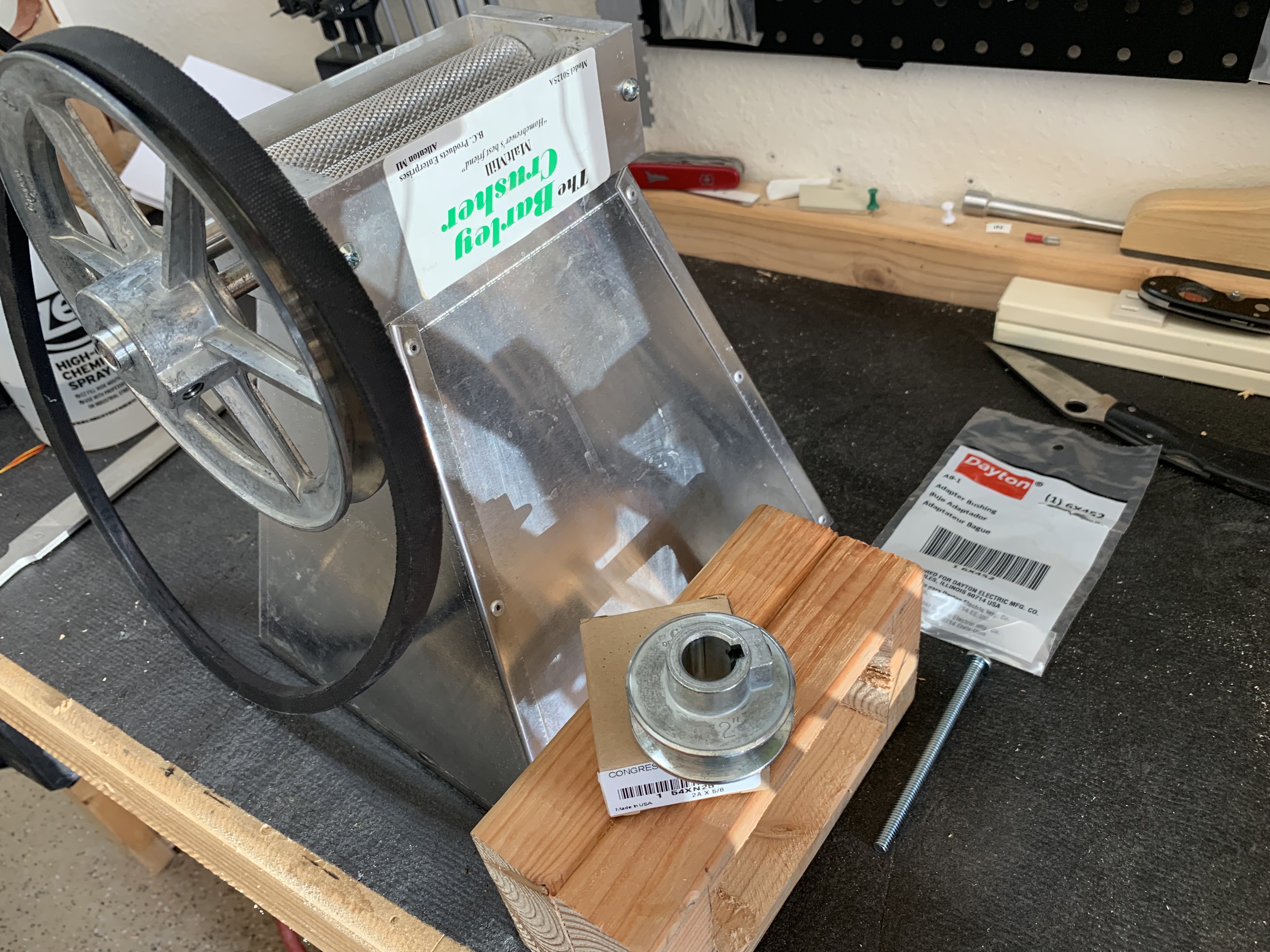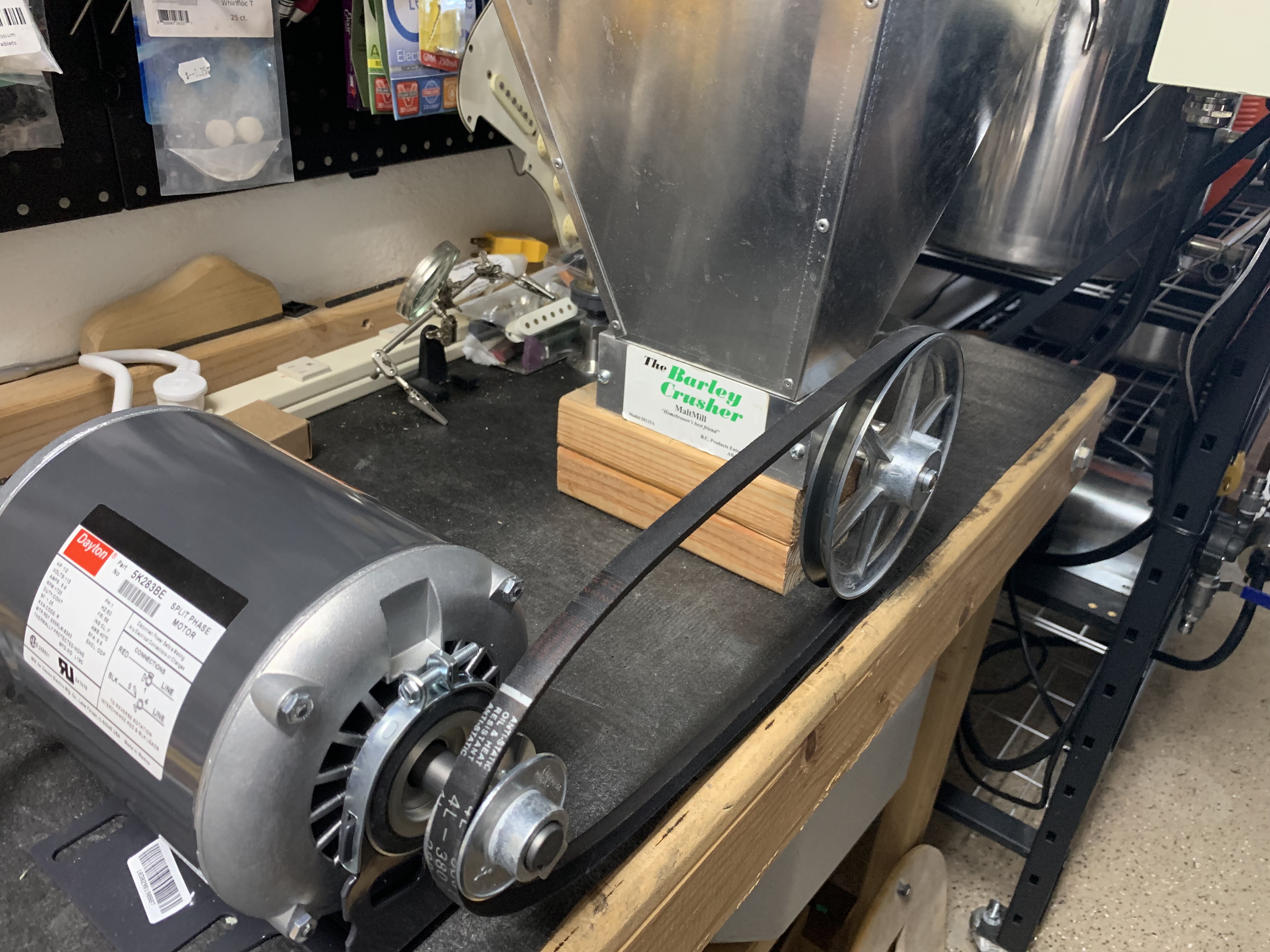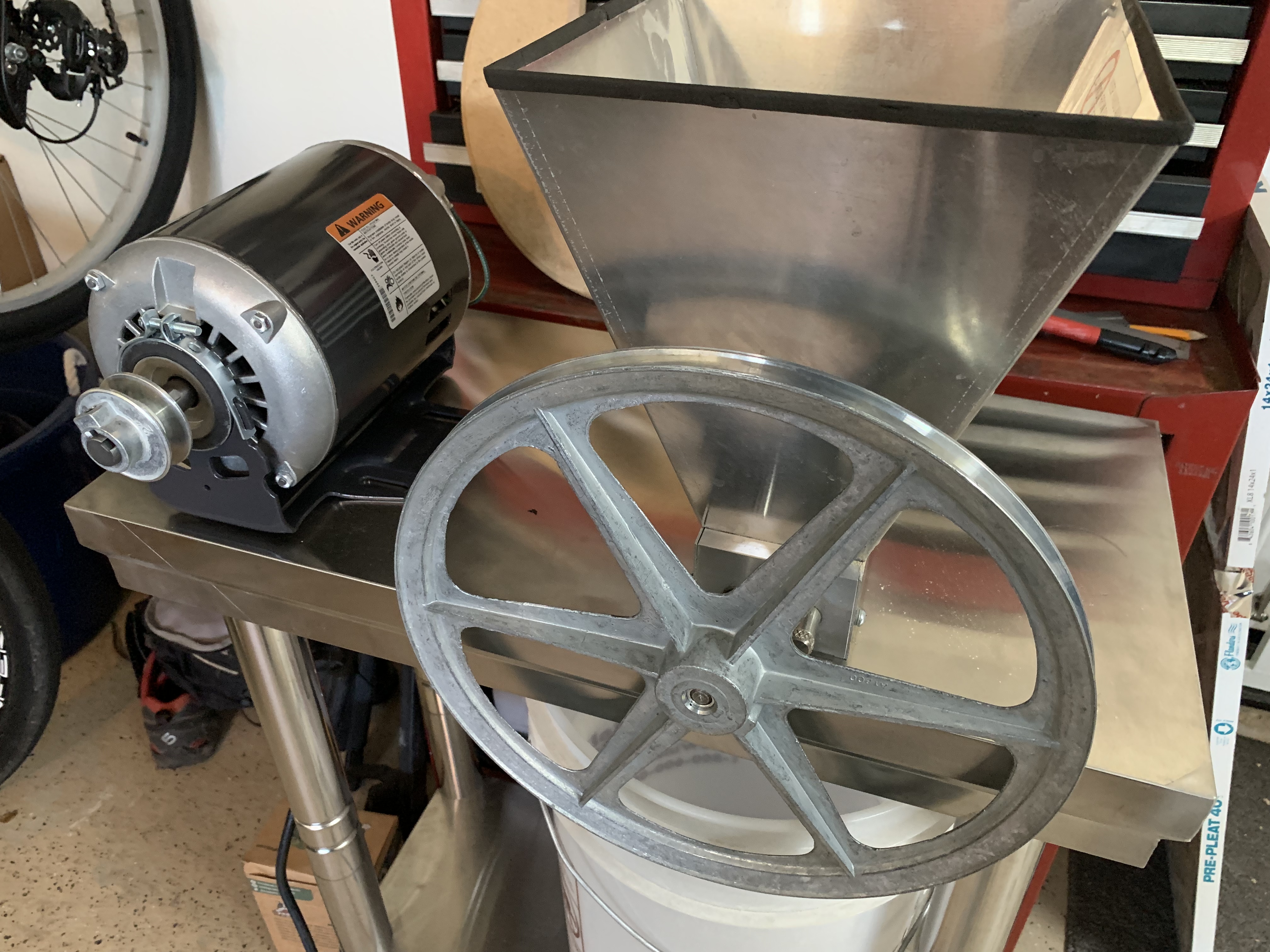You are using an out of date browser. It may not display this or other websites correctly.
You should upgrade or use an alternative browser.
You should upgrade or use an alternative browser.
Electrifying my Barley Crusher Mill
- Thread starter Ntwkdsnr
- Start date

Help Support Homebrew Talk:
This site may earn a commission from merchant affiliate
links, including eBay, Amazon, and others.
Holy cow! That thing could crush gravel now 
But go as easy on the side-loading as possible in consideration of the brass bushings...
Cheers!
But go as easy on the side-loading as possible in consideration of the brass bushings...
Cheers!
are you sure you have the pulleys correct, usually you want the mill slow and powerful not fast
So given a 1725 rpm motor and a target of, say, 172 rpm at the mill shaft, that means the drive pulley circumference should be 1/10th the driven pulley.
Hard to tell from the pic perspective if those are in the ballpark...but they could be...
Cheers!
Hard to tell from the pic perspective if those are in the ballpark...but they could be...
Cheers!
So given a 1725 rpm motor and a target of, say, 172 rpm at the mill shaft, that means the drive pulley circumference should be 1/10th the driven pulley.
Hard to tell from the pic perspective if those are in the ballpark...but they could be...
Cheers!
your right looks close enough, I have mine using a worm gear drive, very slow, never slows down

$719.00
$799.00
EdgeStar KC2000TWIN Full Size Dual Tap Kegerator & Draft Beer Dispenser - Black
Amazon.com

$58.16
HUIZHUGS Brewing Equipment Keg Ball Lock Faucet 30cm Reinforced Silicone Hose Secondary Fermentation Homebrew Kegging Brewing Equipment
xiangshuizhenzhanglingfengshop

$33.99 ($17.00 / Count)
$41.99 ($21.00 / Count)
2 Pack 1 Gallon Large Fermentation Jars with 3 Airlocks and 2 SCREW Lids(100% Airtight Heavy Duty Lid w Silicone) - Wide Mouth Glass Jars w Scale Mark - Pickle Jars for Sauerkraut, Sourdough Starter
Qianfenie Direct

$76.92 ($2,179.04 / Ounce)
Brewing accessories 1.5" Tri Clamp to Ball Lock Post Liquid Gas Homebrew Kegging Fermentation Parts Brewer Hardware SUS304 Brewing accessories(Gas Hose Barb)
chuhanhandianzishangwu

$44.99
$49.95
Craft A Brew - Mead Making Kit – Reusable Make Your Own Mead Kit – Yields 1 Gallon of Mead
Craft a Brew

$22.00 ($623.23 / Ounce)
AMZLMPKNTW Ball Lock Sample Faucet 30cm Reinforced Silicone Hose Secondary Fermentation Homebrew Kegging joyful
无为中南商贸有限公司

$176.97
1pc Commercial Keg Manifold 2" Tri Clamp,Ball Lock Tapping Head,Pressure Gauge/Adjustable PRV for Kegging,Fermentation Control
hanhanbaihuoxiaoshoudian

$53.24
1pc Hose Barb/MFL 1.5" Tri Clamp to Ball Lock Post Liquid Gas Homebrew Kegging Fermentation Parts Brewer Hardware SUS304(Gas MFL)
Guangshui Weilu You Trading Co., Ltd

$49.95 ($0.08 / Fl Oz)
$52.99 ($0.08 / Fl Oz)
Brewer's Best - 1073 - Home Brew Beer Ingredient Kit (5 gallon), (Blueberry Honey Ale) Golden
Amazon.com

$20.94
$29.99
The Brew Your Own Big Book of Clone Recipes: Featuring 300 Homebrew Recipes from Your Favorite Breweries
Amazon.com

$479.00
$559.00
EdgeStar KC1000SS Craft Brew Kegerator for 1/6 Barrel and Cornelius Kegs
Amazon.com

$53.24
1pc Hose Barb/MFL 1.5" Tri Clamp to Ball Lock Post Liquid Gas Homebrew Kegging Fermentation Parts Brewer Hardware SUS304(Liquid Hose Barb)
yunchengshiyanhuqucuichendianzishangwuyouxiangongsi

$7.79 ($7.79 / Count)
Craft A Brew - LalBrew Voss™ - Kveik Ale Yeast - For Craft Lagers - Ingredients for Home Brewing - Beer Making Supplies - (1 Pack)
Craft a Brew
![Craft A Brew - Safale S-04 Dry Yeast - Fermentis - English Ale Dry Yeast - For English and American Ales and Hard Apple Ciders - Ingredients for Home Brewing - Beer Making Supplies - [1 Pack]](https://m.media-amazon.com/images/I/41fVGNh6JfL._SL500_.jpg)
$6.95 ($17.38 / Ounce)
$7.47 ($18.68 / Ounce)
Craft A Brew - Safale S-04 Dry Yeast - Fermentis - English Ale Dry Yeast - For English and American Ales and Hard Apple Ciders - Ingredients for Home Brewing - Beer Making Supplies - [1 Pack]
Hobby Homebrew
Ntwkdsnr
Well-Known Member
Thanks Day_tripper, I'll load it up with just enough to keep the belt going and not slipping.Holy cow! That thing could crush gravel now
But go as easy on the side-loading as possible in consideration of the brass bushings...
Cheers!
bracconiere
Jolly Alcoholic - In Remembrance 2023
It’s coming along. However, maybe the 1/3 HP motor would have been fine. My goal is to spare my nice cordless drills and maybe save time.
View attachment 679033View attachment 679034
you guys give me crap for drinking more, but you take brewing a lot more seriously than me!! nice set-up!

Ugh - I was afraid those pulleys didn't look different enough.
I don't think those ratios are going to produce 300 rpm - which tbh is on the high side of the CW on desirable mill speed of around 180-200 rpm (said CW admittedly tends to ignore roller diameter, but let's move along).
Anyway, on a belt drive, pulley circumference is what matters.
Circumference is Pi * Diameter, so the 2" pulley circumference is ~ 6.25" while the 6" is 18.5", for a ratio of ~.33.
Given the motor will spin at a fixed 1725 rpm the mill will be spinning at roughly 570 rpm. No bueno.
A 1.5" drive pulley with a 12" driven pulley would be a good solution with the mill ending up around 215 rpm. Definitely in the acceptable range....
Cheers!
I don't think those ratios are going to produce 300 rpm - which tbh is on the high side of the CW on desirable mill speed of around 180-200 rpm (said CW admittedly tends to ignore roller diameter, but let's move along).
Anyway, on a belt drive, pulley circumference is what matters.
Circumference is Pi * Diameter, so the 2" pulley circumference is ~ 6.25" while the 6" is 18.5", for a ratio of ~.33.
Given the motor will spin at a fixed 1725 rpm the mill will be spinning at roughly 570 rpm. No bueno.
A 1.5" drive pulley with a 12" driven pulley would be a good solution with the mill ending up around 215 rpm. Definitely in the acceptable range....
Cheers!
Ntwkdsnr
Well-Known Member
Different v-belt pulleys are easy to get. But now it got me thinking of the effects of milling at higher RPMs. Will is work? Will it not produce consistent crush? I will have to run some tests. My other thought was some sort of speed controller. However, I assume that this is an AC induction type motor which will require changing the frequency of the input and not the voltage. Probably way more $$$ than new v-belt pulleys.Ugh - I was afraid those pulleys didn't look different enough.
I don't think those ratios are going to produce 300 rpm - which tbh is on the high side of the CW on desirable mill speed of around 180-200 rpm (said CW admittedly tends to ignore roller diameter, but let's move along).
Anyway, on a belt drive, pulley circumference is what matters.
Circumference is Pi * Diameter, so the 2" pulley circumference is ~ 6.25" while the 6" is 18.5", for a ratio of ~.33.
Given the motor will spin at a fixed 1725 rpm the mill will be spinning at roughly 570 rpm. No bueno.
A 1.5" drive pulley with a 12" driven pulley would be a good solution with the mill ending up around 215 rpm. Definitely in the acceptable range....
Cheers!
Brettomomyces
LHBS Curmudgeon
Ugh - I was afraid those pulleys didn't look different enough.
I don't think those ratios are going to produce 300 rpm - which tbh is on the high side of the CW on desirable mill speed of around 180-200 rpm (said CW admittedly tends to ignore roller diameter, but let's move along).
Anyway, on a belt drive, pulley circumference is what matters.
Circumference is Pi * Diameter, so the 2" pulley circumference is ~ 6.25" while the 6" is 18.5", for a ratio of ~.33.
Given the motor will spin at a fixed 1725 rpm the mill will be spinning at roughly 570 rpm. No bueno.
A 1.5" drive pulley with a 12" driven pulley would be a good solution with the mill ending up around 215 rpm. Definitely in the acceptable range....
Cheers!
Exactly the pulley setup I use, 1.5" drive and 12" driven
lump42
The Lajestic Vantrashell of Lob
I have noticed more torn and shredded husks when I mill at a high speed. For the most part, I ditched the drills because I had trouble maintaining a slow speed and have moved to just using the hand crank. I get a much better crush with almost all the hulls are intact. It's now just a little bit of exercise.Different v-belt pulleys are easy to get. But now it got me thinking of the effects of milling at higher RPMs. Will is work? Will it not produce consistent crush? I will have to run some tests. My other thought was some sort of speed controller. However, I assume that this is an AC induction type motor which will require changing the frequency of the input and not the voltage. Probably way more $$$ than new v-belt pulleys.
Carolina_Matt
Well-Known Member
- Joined
- Jan 24, 2018
- Messages
- 492
- Reaction score
- 261
I have noticed more torn and shredded husks when I mill at a high speed. For the most part, I ditched the drills because I had trouble maintaining a slow speed and have moved to just using the hand crank. I get a much better crush with almost all the hulls are intact. It's now just a little bit of exercise.
A couple questions:
1 - How long does it take you to use the hand crank for about 10 lbs or so?
2 - What do you consider 'high speed'?
It never occurred to me to use the hand crank, but I'm usually not in a hurry and exercise is good. If it's a 20 minute job though, I'm sure it would get old pretty quickly. And my drill is variable speed with a lower setting of 0-450 rpm. I generally try to pull the trigger about 2/3 of the way, to get closer to 300 rpm, although I obviously can't hold it in the same exact spot the whole time. Is 300-450 rpm enough to tear/shred the husks, or are you talking more in terms of the 1,000 rpm that some drills have?
Ntwkdsnr
Well-Known Member
I have the hand crank for the mill but.......I'm milling 20# or so most of the time. I'm trying to shorten my brew dayI have noticed more torn and shredded husks when I mill at a high speed. For the most part, I ditched the drills because I had trouble maintaining a slow speed and have moved to just using the hand crank. I get a much better crush with almost all the hulls are intact. It's now just a little bit of exercise.
lump42
The Lajestic Vantrashell of Lob
I've never kept track of the time, but it takes more time to weight the grain out than it does to mill it by hand. No more than 5-7 min for 10-12 lbs grist.A couple questions:
1 - How long does it take you to use the hand crank for about 10 lbs or so?
2 - What do you consider 'high speed'?
It never occurred to me to use the hand crank, but I'm usually not in a hurry and exercise is good. If it's a 20 minute job though, I'm sure it would get old pretty quickly. And my drill is variable speed with a lower setting of 0-450 rpm. I generally try to pull the trigger about 2/3 of the way, to get closer to 300 rpm, although I obviously can't hold it in the same exact spot the whole time. Is 300-450 rpm enough to tear/shred the husks, or are you talking more in terms of the 1,000 rpm that some drills have?
My drill doesn't have a set rpm that I'm aware. I'm not great at counting rpms in the hundreds by eye. I'm going off of the outcome. But I have issues with several drills, battery and corded, even the hammer drill. At the lower speeds there isn't enough torque to turn the mill, and by the time it has enough torque it's going faster than I like and shredding husks.
lump42
The Lajestic Vantrashell of Lob
I have the hand crank for the mill but.......I'm milling 20# or so most of the time. I'm trying to shorten my brew day
I hand milled the 22lbs barleywine grist this past winter. It only took 10-12 min. I mill the evening or two before so it's not adding to the actual brewday.
I would have considered attaching a motor to slow it down, but 1) I'm cheap, 2) l don't have the space, and 3) not the type of diy project I'm interested in.
- Joined
- Aug 12, 2013
- Messages
- 2,066
- Reaction score
- 2,729
From the picture, your motor spins at 1725 RPM. To get to 300 RPM you will need a 3" pulley on the motor and a 17.25" pulley on the mill.
Similar threads
- Replies
- 0
- Views
- 283
- Replies
- 7
- Views
- 796
- Replies
- 8
- Views
- 869













































